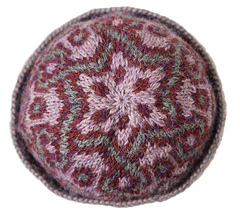patterns >  Extreme Double-Knitting: Revised Edition and 3 more...
Extreme Double-Knitting: Revised Edition and 3 more...
> Falling Blocks





Falling Blocks
From the pattern:
I consider this hat sort of my flagship piece. I even named it after my online handle. Despite appearances, the name “Fallingblox” is not derived from this pattern — it is a reference to my erstwhile and sometime obsession with Tetris and falling blocks games in general. I took the handle a long time before I started knitting. Also, the correct name for the Layer-1 pattern on this piece is “tumbling blocks”. But the accomplishment of a two-pattern piece with three colors in every round is still something I consider worthy of a place of honor in my repertoire of patterns.
That said, this hat is very warm. Warm enough for a winter in the Arctic, probably. At the brim fold, it’s about 5 layers thick, and it’s made of alpaca-blend wool. One layer is a typical tumbling blocks pattern; the other appears to be a simple Celtic knot but is actually a chart I got as part of a collection from the Armenian Museum in Watertown, MA.
What’s New?
Like the previous pattern, this hat is worked in a lighter version of the yarn used for the original one. Berroco Ultra Alpaca Light is the sport weight version of Berroco Ultra Alpaca, and I expected something similar to happen when I swatched in the lighter yarn as happened with the Cascade. Strangely enough, it didn’t. The original Falling Blocks pattern was done entirely in twisted stitches. Since I am no longer designing things this way, I removed the twisted stitch requirement for this hat. When I swatched (untwisted) in the Ultra Alpaca Light, on correspondingly smaller needles, I ended up matching my worsted (twisted) gauge perfectly. This was a surprise, but a pleasant one: I didn’t need to change the pattern at all, and the fabric is still more wearable than the previous version.
However, that wasn’t all I wanted to do with this hat. Originally, I had created a pattern that used two different all-over charts, but only up to the crown decreases. I didn’t want to have to figure out how to decrease both charts at the same time, so I made an elegant end to the Layer-2 chart before the crown decreases began and opted for a color-rotated version of the crown instead. This had always irked me, so for the updated version, I figured out a clean closure that works for both layers. However, it did require a new way of thinking about double-knit decreases in two-pattern charts.

11734 projects
stashed
10775 times
- First published: January 2010
- Page created: January 25, 2010
- Last updated: April 25, 2020 …
- visits in the last 24 hours
- visitors right now




